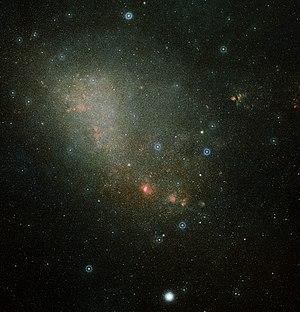
Back Klein Magellaanse Wolk AF سحابة ماجلان الصغرى Arabic سحابة ماجلان الصغيره ARZ NGC 292 AZ Малое Магеланава Воблака BE Малък Магеланов облак Bulgarian Koumoulenn vihan Magellan BR Mali Magellanov oblak BS Petit Núvol de Magalhães Catalan NGC 292 CE
| Small Magellanic Cloud | |
|---|---|
 The Small Magellanic Cloud (Source: Digitized Sky Survey 2) | |
| Observation data (J2000 epoch) | |
| Constellation | Tucana and Hydrus |
| Right ascension | 00h 52m 44.8s[1] |
| Declination | −72° 49′ 43″[1] |
| Redshift | 0.000527[1] |
| Distance | 203.7 ± 1.5 kly (62.44 ± 0.47 kpc)[2] |
| Apparent magnitude (V) | 2.7[1] |
| Characteristics | |
| Type | SB(s)m pec[1] |
| Number of stars | 3 billion[4] |
| Size | 5.78 kiloparsecs (18,900 light-years)[1] (diameter; 25.0 mag/arcsec2 B-band isophote)[3] |
| Apparent size (V) | 5° 20′ × 3° 5′[1] |
| Notable features | Companion dwarf to the Milky Way |
| Other designations | |
| SMC,[1] NGC 292,[1] PGC 3085,[1] Nubecula Minor[1] | |
The Small Magellanic Cloud (SMC) is a dwarf galaxy near the Milky Way.[5] Classified as a dwarf irregular galaxy, the SMC has a D25 isophotal diameter of about 5.78 kiloparsecs (18,900 light-years),[1][3] and contains several hundred million stars.[5] It has a total mass of approximately 7 billion solar masses.[6] At a distance of about 200,000 light-years, the SMC is among the nearest intergalactic neighbors of the Milky Way and is one of the most distant objects visible to the naked eye.
The SMC is visible from the entire Southern Hemisphere and can be fully glimpsed low above the southern horizon from latitudes south of about 15° north. The galaxy is located across the constellation of Tucana and part of Hydrus, appearing as a faint hazy patch resembling a detached piece of the Milky Way. The SMC has an average apparent diameter of about 4.2° (8 times the Moon's) and thus covers an area of about 14 square degrees (70 times the Moon's). Since its surface brightness is very low, this deep-sky object is best seen on clear moonless nights and away from city lights. The SMC forms a pair with the Large Magellanic Cloud (LMC), which lies 20° to the east, and, like the LMC, is a member of the Local Group. It is currently a satellite of the Milky Way, but is likely a former satellite of the LMC.
- ^ a b c d e f g h i j k l "NASA/IPAC Extragalactic Database". Results for Small Magellanic Cloud. Retrieved 2006-12-01.
- ^ Graczyk, Dariusz; Pietrzyński, Grzegorz; Thompson, Ian B.; Gieren, Wolfgang; Zgirski, Bartłomiej; Villanova, Sandro; Górski, Marek; Wielgórski, Piotr; Karczmarek, Paulina; Narloch, Weronika; Pilecki, Bogumił; Taormina, Monica; Smolec, Radosław; Suchomska, Ksenia; Gallenne, Alexandre; Nardetto, Nicolas; Storm, Jesper; Kudritzki, Rolf-Peter; Kałuszyński, Mikołaj; Pych, Wojciech (2020). "A Distance Determination to the Small Magellanic Cloud with an Accuracy of Better than Two Percent Based on Late-type Eclipsing Binary Stars". The Astrophysical Journal. 904 (1): 13. arXiv:2010.08754. Bibcode:2020ApJ...904...13G. doi:10.3847/1538-4357/abbb2b. S2CID 224706414.
- ^ a b De Vaucouleurs, Gerard; De Vaucouleurs, Antoinette; Corwin, Herold G.; Buta, Ronald J.; Paturel, Georges; Fouque, Pascal (1991). Third Reference Catalogue of Bright Galaxies. Bibcode:1991rc3..book.....D.
- ^ Jonathan Powell (17 September 2018). Rare Astronomical Sights and Sounds. Springer. ISBN 978-3-319-97701-0.
- ^ a b Nemiroff, R.; Bonnell, J., eds. (2006-06-17). "The Small Cloud of Magellan". Astronomy Picture of the Day. NASA. Retrieved 2008-07-07.
- ^ Bekki, Kenji; Stanimirović, Snežana (2009-05-01). "The total mass and dark halo properties of the Small Magellanic Cloud". Monthly Notices of the Royal Astronomical Society. 395 (1). Oxford University Press (OUP): 342–350. arXiv:0807.2102. Bibcode:2009MNRAS.395..342B. doi:10.1111/j.1365-2966.2009.14514.x. ISSN 0035-8711. S2CID 18268139.